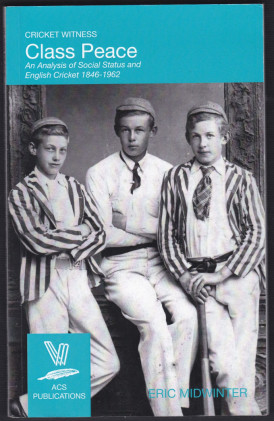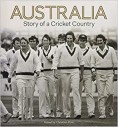Class Peace: An analysis of social status and English cricket 1846-1962
Jon Gemmell |Published: 2017
Pages: 146
Author: Midwinter, Eric
Publisher: ACS
Rating: 4.5 stars

In this work the prolific historian Eric Midwinter looks firstly at the Victorian age and then beyond to when cricket became established as a national sport. A key consideration is given to how society shaped the forces of social class and how this in turn affected cricketing relations between professionals and their ‘masters’.
The volume makes for a fine account of the times, with the author discussing the infatuation with gambling in stocks and shares alongside the overcrowded towns and the growth of transport. This social context is set alongside the contemporary literature of the times, with liberal references to Dickens, Kipling and Trollope. There are the origins of words such as ticket (not employed until the late 17th century), the first use of numbers representing classes (1807 when Oxford and Cambridge Universities introduced the first, second- and third-class degrees), and the introduction of white clothing between 1880 and 1895 replacing the coloured clothing so frowned upon by traditionalists later on.
In this environment, the professional cricketer became part of the entertainment industry. Although from the working-class, they tended to come from the artisan rather than a labouring background and were better paid than their proletarian neighbours. Many were piece workers, able to combine a trade in lace or other crafts into paid cricket when called upon. This was less easy for those who relied on the farm or the factory for employment.
The title of the work suggests a period of amity between the social classes, but this didn’t prevent owners from restricting opportunities to those from a manual background. In 1873, for example, a decision was taken that no player could play for more than one county in a season, thus restricting the free movement of labour and reinforcing the notion of the master and servant relationship. Attempts at industrial action – in 1881 and 1896 – were met with ‘ruthless firmness’. Grounds and membership of many clubs were enclosed to restrict access to the ‘common horde.’
Midwinter’s thesis relies on the idea of corporatism as the main reason for social stability in this period. The provision of municipal parks and open spaces for healthy exercise, for example, provided cricket with the grounds for the broader public to take part and attend games. Macclesfield Park hosted some 40 matches on Saturday afternoons.
He includes two iconic figures to uphold his claim. Lord Harris whilst Chancellor of the Primrose League might have subscribed to their values of ‘bringing rich and poor together … to [unite] all classes in a common crusade against the forces of atheism and revolution.’ Whereas Lord Hawke was more certain in his memoirs: ‘high and low, rich and poor, greet one another practically on an equality, and sad will be the day for England if socialism ever puts class v class and thus ending sports which have made England.’ Yet, these examples sought class peace as a means of delaying socialism, a political creed designed to improve the lot of the masses. I’m not as optimistic as the author about the plight of the workers in this period and would welcome, by contrast, a study on how many first-class cricketers lived out their days in the workhouse.
To be fair, Midwinter is not without criticism of pre-war society, describing it as discriminatory, puritanical and oppressive. But he sees something ‘congregational’, about bringing people together and the consideration of others. This period was replaced by a social structure that was more self-based and individualistic. He cites deregulation of the banks, privatisation, lowering of taxation and the subsequent reduced state expenditure as examples of how society became more unequal, both materially and culturally. This neo-liberal phase is in many ways more reminiscent of the 18th than 19th century in character. The gambling, corruption and misbehaviour that bedevilled the sport in the Hanoverian and Regency eras has returned.
Social mobility following the Second World War meant more opportunities in local government, education and the health sector. Cricket was no longer an escape from the drudgery of manual work. A combination of trade union organisation and Kerry Packer’s commercialism led to improved conditions and cricketers are now in employment rather than service, with contracts rather than feudalistic obligations. They are rewarded at something like twice the national average income, suggesting that they have all become middle-class, meaning that professional cricket has become a single-class occupation rather than the cross-class activity of the past.
Midwinter’s conclusion, whilst apposite is quite depressing. Most cultural artefacts, he notes, don’t die, but simply fade away, with adherents hanging on for as long as possible. Followers of first-class cricket, especially in its longer form, may soon be considered alongside steam train enthusiasts. The arrival of The Twenty next year only hurries the inevitable. Certainly, cricket is heading for change, but when historians reflect on this peculiar sport that we all admire, they will be reading Midwinter to ascertain the reasons for its transformation/demise.






Leave a comment